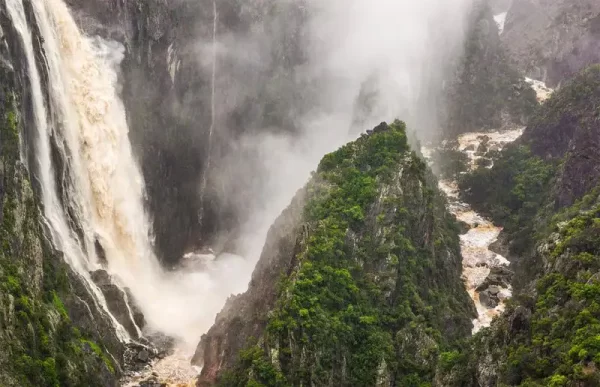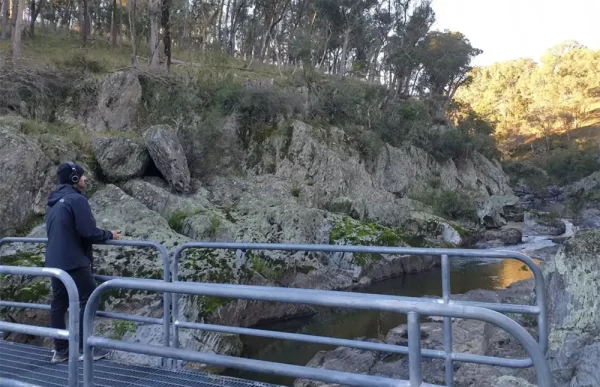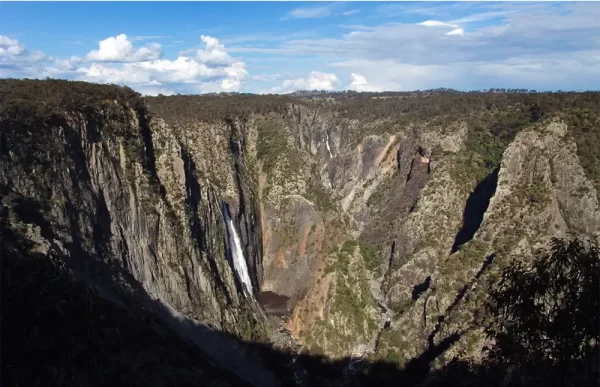Click on any of the soundfields on the map above to play a story. Note: On location, GPS would trigger these stories automatically.



East of Armidale, Wollomombi Falls is one of the country’s largest waterfalls. You can often see torrents of water cascading from the grassy New England tableland into the vast and wild gorge system beneath it.
The name Wollomombi derives from an Aboriginal word meaning the meeting of two waters, but a lot of local elders simply refer to it as the place of the lyrebird.
Tracing the Wollomombi gorge rim, this trail takes in four breathtaking lookouts and two incredible waterfalls. It offers a rare glimpse into the ecology, colonial history, and the traditional stories embedded in this ancient landscape.
Armidale elder Steve Widders guides walkers along the trail, as we hear the lyrebird Dreaming story, the poetry of Judith Wright, and how this place opens a window into the evolution of life on earth since the time of the Gondwana supercontinent.
Before venturing out check the NPWS website for the latest park information.
Credits & Contributors
This Soundtrail received grant funding from the Australian Government, brought to you by New England High Country tourism group in partnership with Soundtrails.
Produced by Nicole Curby 2020/21
With supervising producer Sharon Davis and guide Steve Widders
Thanks to NSW NPWS, Adam Baillie, Katrina George, Piers Thomas, Armidale Historical Society, John Atkinson, Armidale Local Aboriginal Land Council, Lisa Waters, University of New England Archives and Heritage Centre, Jo Willey, Aboriginal Cultural Centre and Keeping Place, William Oates, Catherine Wright, Les Ahoy, Steven Ahoy, Heath Milne, Ron Edgar, Esma McRae, Cindy McRae, Don Noakes, Tricia Waters, Gondwana Rainforests NSW National Parks.
A living link
Featuring Piers Thomas (NPWS) and Tricia Waters (Gondwana Rainforests Executive Officer, NPWS)
Images: Dry rainforest (NPWS)
Evolution of song birds
Featuring: Heath Milne (ecologist and birdwatcher), Tricia Waters (Gondwana Rainforests Executive Officer, NPWS)
Images: Superb lyrebird (Elinor Sheargold / DPIE)
Tricia Waters (Nicole Curby)
Falls Country
Images: Judith Wright (The University of Queensland Library)
Catherine Wright (Nicole Curby)
Lyrebird Dreaming
Images: Superb lyrebird (Ken Stepnell/DPIE)
Les Ahoy (Nicole Curby)
News is Coming
Images, Willy wagtail (Lip Kee; Simone Cottrell/DPIE)
The Dog Fence
Featuring: Piers Thomas (NPWS), Ron Edgar and Esma McRae (former graziers), Don Noakes (grazier, and Wild Dog Association)
Images: A handwoven section of the old dog fence remains on the Wollomombi gorge rim (Adam Baillie)
Dingoes (Andrew Claridge/DPIE)
Wild dogs (NPWS)
Vulnerable Birds
Featuring, Heath Milne (ecologist and bird watcher)
Images, Flame Robin (Patrick Kavanagh)
Scarlet Robin (Lee Kip)
Speckled warbler (Patrick Kavanagh)
Crested shrike tit (JJ Harrison)
Writing the George Country
Featuring: Catherine Wright (writer), William Oates (archivist)
Images: A young Judith Wright at Wallamumbi station, with her father Phillip Arundel Wright, mother Ethel Mabel Wright, brothers Peter and Brucie and grandfather Alfred Bigg. (c. 1913-1925) (University of New England Archives and Heritage Centre.)
